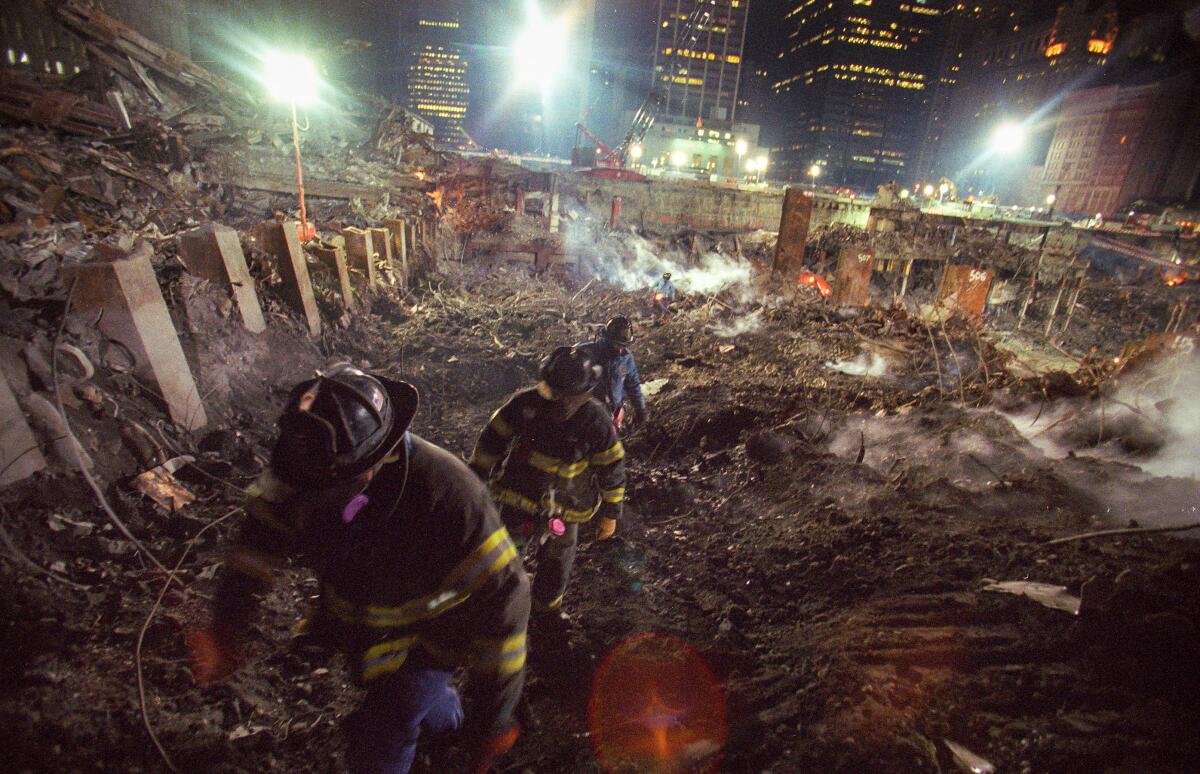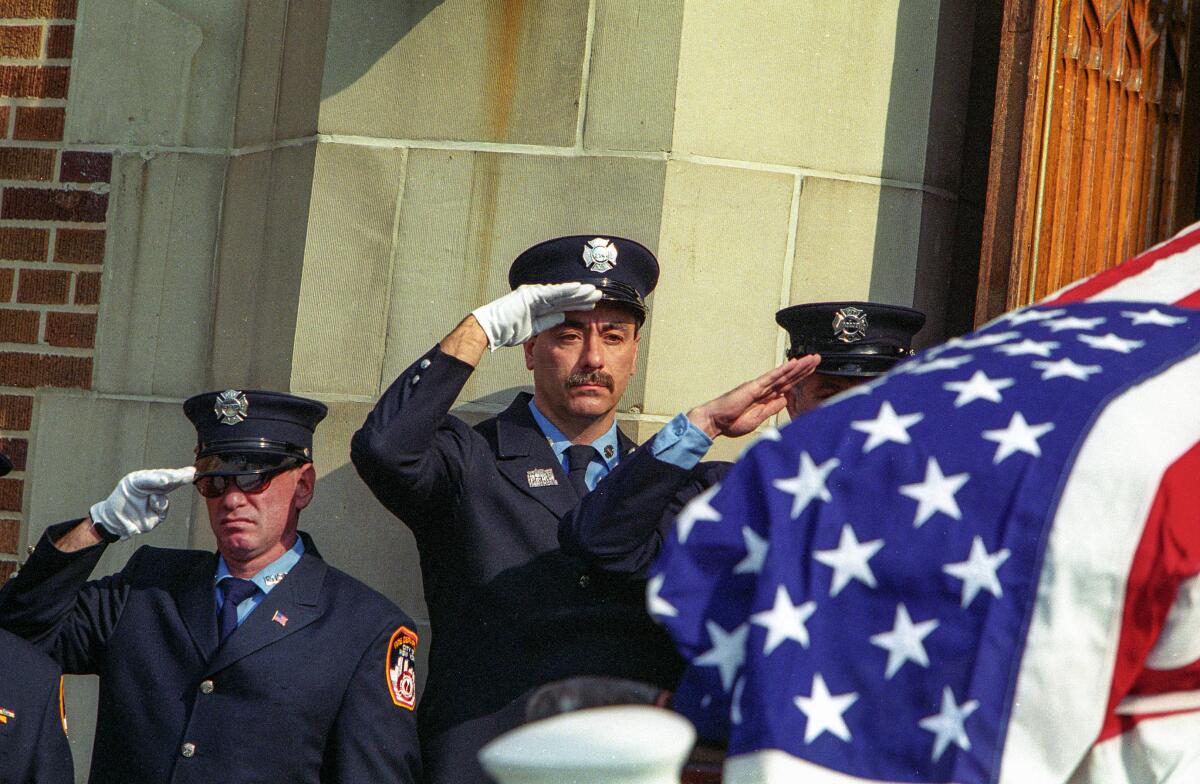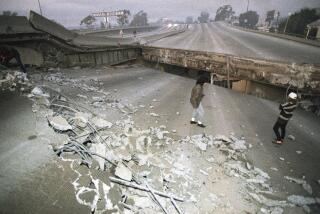From the Archives: After 9/11, photographer Gary Friedman remembers his coverage of Rescue 5

Following the terrorist attacks of Sept. 11, 2001, Los Angeles Times staff members rushed to New York. Staff photographer Gary Friedman was among the first to arrive. For a year after 9/11, Friedman covered the survivors and families of Rescue 5.
Part of the Los Angeles Times’ 2011 coverage of the 10th anniversary of 9/11 included followup reporting on members of Rescue 5. In this blog, Friedman reflected on how he met and followed members of the Staten Island fire company:
My relationship with the Rescue Company 5 from Staten Island began by happenstance.
Following the attacks of Sept. 11, I stayed in New York covering the swirl of events for my newspaper. On most days there would be a memorial service for one of the 343 firefighters killed in the attacks. They were the first-responders, the ones who would rush into a burning building even if they knew they would not return.

One October day I found myself at yet another memorial service. The haunting yet beautiful sound of bagpipes would always lead the procession. This day it was for John Bergin, one of 11 firefighters from the Rescue 5 unit -- an elite group of firefighters -- who died at the World Trade Center site. (Bill Spade was the only survivor of the 12 company members who reached the towers that day; he had gone in a separate vehicle.)
The flag-draped coffin was at the front of the church. I didn’t know at the time that the coffin was empty; Bergin’s remains were never found.
Gerry Koenig began to speak about his close friend, how they started at the Rescue Company together. Everyone in the church was moved. I tried to keep focus through the tears I was also shedding as Gerry spoke about his dear friend. His words resonated and still stay with me to this day. He spoke of the bond of the firemen brotherhood. More than just colleagues, they were a family. As he spoke, it seemed I was also getting to know John Bergin.
The family followed the casket out of the church, with John Jr. carrying his father’s helmet and eldest daughter Katie carrying the American flag.
After the service I sought out the firehouse. It is an old building, nearly 100 years old, with the character, perhaps, of a historical monument.
I introduced myself to Capt. John Ferry, who was just returning from the memorial service. I asked if I could spend some time at the firehouse and perhaps ride one day with the men down to the “pile” (as the firefighters commonly referred to the World Trade Center site).
He pointed to the rig and said, “Hop on.”
I didn’t expect to hear that at this particular moment and I politely asked to go another time when I was more prepared.
The bond of trust between Rescue 5 and me had begun.
I spent many days during the following year documenting the company as they searched for their colleagues and how they were getting through each month. For the next nine months the surviving members of the company would go down to the pile.
On two occasions I rode in the rig taking the same route over the Verrazano-Narrows Bridge through the Holland Tunnel into lower Manhattan, the same route the 11 took that fateful day. I sat across from Gerry Koenig; the lights of Manhattan glistened in his eyes. I wondered if he was thinking about his close friend, John Bergin. I felt honored to be on the truck with them.
At the site, the company watched me like a hawk, making sure I didn’t stumble in the rubble.
On the first “tour” we went down many flights of stairs to where the subways and the Long Island Rail Road once ran.
This is what a collapsed mine might look like, I thought.
The second tour with the company was above ground. As the men would search through the rubble, Joe Esposito was not only looking for his fallen comrades but also for his brother Michael and cousin Frank. They were with other engine companies when the towers fell, and they never returned.
During the next year I returned many times to document the company. On Christmas night, 2001, I found Capt. Ferry washing the helmet of Allan Tarasiewcz. Part of his remains were later identified. His helmet and a crowbar were the only other Rescue 5 items recovered.
I photographed the company, led by Ferry, as they marched in the Staten Island St. Patrick’s Day Parade in 2002.
I was there in May 2002 when Madeline Bergin, John’s widow, was comforted by Rescue 5 retiree Gus Tripoli.
I followed Bill Spade to Fargo, N.D., where he served as grand marshal of the July 4 parade in 2002.
It has been more than nine years since I was last at the firehouse. Bill and I have remained in contact through the years.
Our newspaper decided to revisit Bill, Madeline and Joe Esposito once again and see how they are doing. Ten years later they are coping, perhaps a little better, but still remain in pain in one degree or another. Bill now gives tours at the WTC Tribute Center, Madeline has remarried to Gerry, and Joey is still, after all these years, the big brother in the firehouse and watches over the widows.
This summer, en route to my hotel after having passed over the Verrazano-Narrows Bridge, I could see something through the haze on the left side along the freeway.
The firehouse.
I decided to stop, and I asked if Tom Inhken was working. When he came out we had a long hug.
He introduced me to the others, all new faces. To this stranger they never met, the traditional brotherhood of firemen all held out their welcoming hands. I was later invited to dinner one evening.
It was great to be back.
::

This post originally appeared on Aug. 30, 2011.
Gary Friedman passed away in 2017. His obituary is online.

More to Read
Start your day right
Sign up for Essential California for news, features and recommendations from the L.A. Times and beyond in your inbox six days a week.
You may occasionally receive promotional content from the Los Angeles Times.






